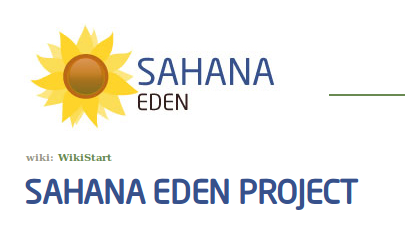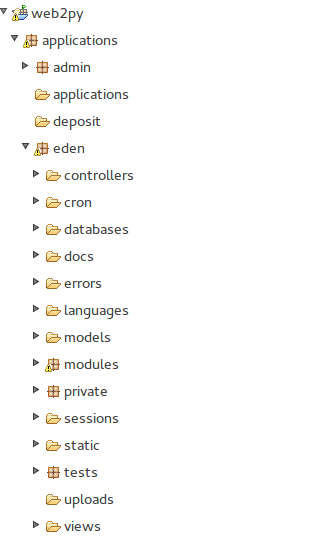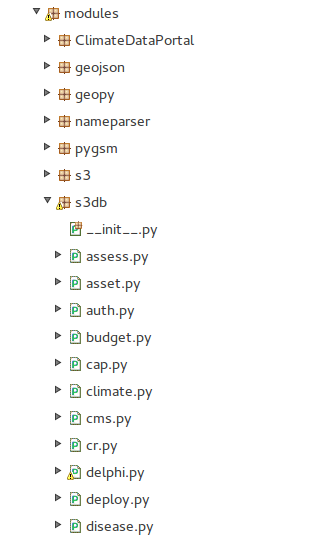CSC/ECE 517 Fall 2014/final S1455: Difference between revisions
No edit summary |
|||
| Line 88: | Line 88: | ||
Although this uses a web service, you get better results by downloading a local version of the Closure Compiler (a tool for making JavaScript download and run faster) to static/scripts/tools. It is also possible to quickly view a single page in debug mode by adding the ?debug=1 variable to the end of a URL. | Although this uses a web service, you get better results by downloading a local version of the Closure Compiler (a tool for making JavaScript download and run faster) to static/scripts/tools. It is also possible to quickly view a single page in debug mode by adding the ?debug=1 variable to the end of a URL. | ||
==Further Reading== | ==Further Reading== | ||
Revision as of 02:45, 12 November 2014
This wiki page contains design details for the project for Sahana Eden Humanitarian Platform, on their Central African Republic deployment.
Background Information
About Sahana Eden
Sahana Eden is an Open Source Humanitarian Platform, which can be used to provide solutions for Disaster Management, Development, and Environmental Management sectors. It is supported by the Sahana Software Foundation, Used in many Deployments, such as Ebola, Kashmir Floods, Hurricane Sandy, just to name a few.
Installation & tutorials
Anyone who wishes to contribute their development skill to Sahana, can do so with the help of an elaborate guide they have provided, that covers everything from installation to tutorials on Python. Once the installations are complete, you can simply identify a task you are interested in, and start working on it. You may also want to sign their Contributor's License Agreement before making any pull request.
Getting to know the domain
Their domain page elaborately describes various major management projects and deployments that are done in the past or are ongoing. Spending some time to understand goals and purposes of Sahana before starting with actual development might help making the code better and more sensible from Sahana's perspective.
Introduction to project
Overview
In the Central African Republic page, some data needs new models, and some models need tweaking. The purpose of this project is to identify any such requirement and make necessary changes. The general steps to follow in Sahana development are mentioned below-
1. Add/modify the core models in modules/s3db
2. Add REST controllers for new models
3. Check basic operations using automatic CRUD interface- tweak list_fields to the most-relevant fields perhaps
4. Add menu entries (modules/s3menus.py)
5. Develop XSLT & CSV templates (static/formats/s3csv) to bulk import the data
6. Convert the data to these CSV templates- use ogr2ogr for this
7. Add layers to the map (private/templates/<TEMPLATE>/gis_layer_feature.csv. Look at default for now) including Markers and tooltips (popup_format)
8. Provide some report_options to make a meaningful report
Scope
Four modules related to this deployment are-
1. Health - modules/s3db/hms.py
2. Transport - modules/s3db/transport.py
3. Water - modules/s3db/water.py
4. School - There is no seperate module for education.
Reference Material
Border Control Points, Roads, Routes, Airports
Water Bodies, Water Points, Rivers
System Overview
Sahana Eden is mainly implemented using Python, web2py, CSS and foundation. When you open the code in Eclipse, you can see that web2py is very much like Ruby on Rails. Analyze the screenshots below-
Our focus is on Controllers, Models, Modules and views. For every action on various pages on Sahana Humanitarian website, there are set of controllers defined. As mentioned above, we want to focus on 4 models- health, transport, water and school. For school, thers is no seperate module defined. We can define a module named education.
System Architecture
Requirement Analysis
Data and Component Design
Design Principles
Proposed Test Cases
For end-user performance gains, Sahana Eden minimizes and compresses the CSS and JavaScript. While this approach works well for optimized end-user performance, to debug the CSS and JavaScript we shall enable debug mode in models/000_config.py in our Sahana Eden server with the following setting:
settings.base.debug = True
Once any changes to the CSS and JavaScript are working, then we can minimizes and compresses the CSS and JavaScript using:
static/scripts/tools/build.sahana.py
Although this uses a web service, you get better results by downloading a local version of the Closure Compiler (a tool for making JavaScript download and run faster) to static/scripts/tools. It is also possible to quickly view a single page in debug mode by adding the ?debug=1 variable to the end of a URL.
Further Reading
Public Google Forum to discuss any development issues
Sahana Launches EUROSHA Humanitarian Data Site
Central African Republic: UN urges support to meet basic needs in hard-hit province
 |

